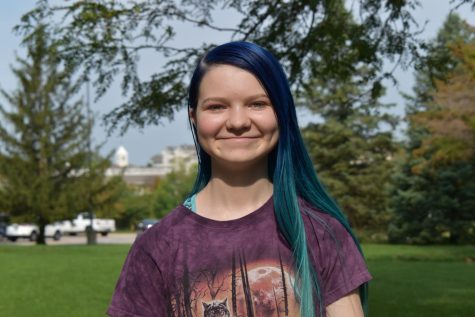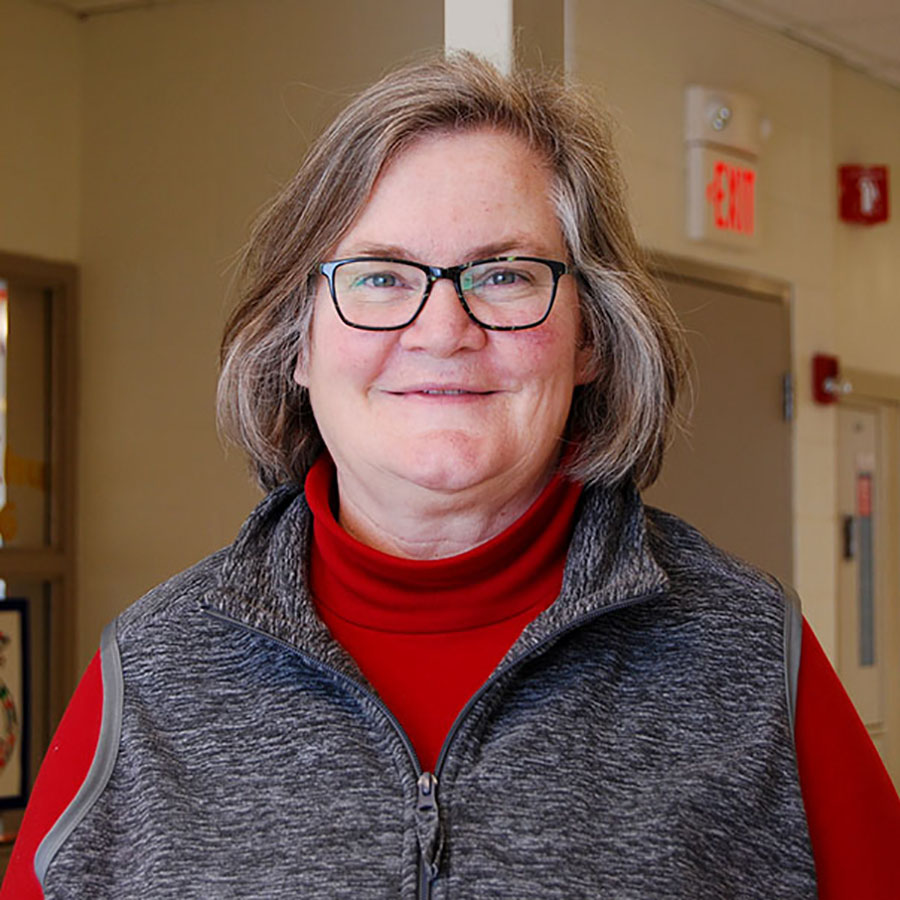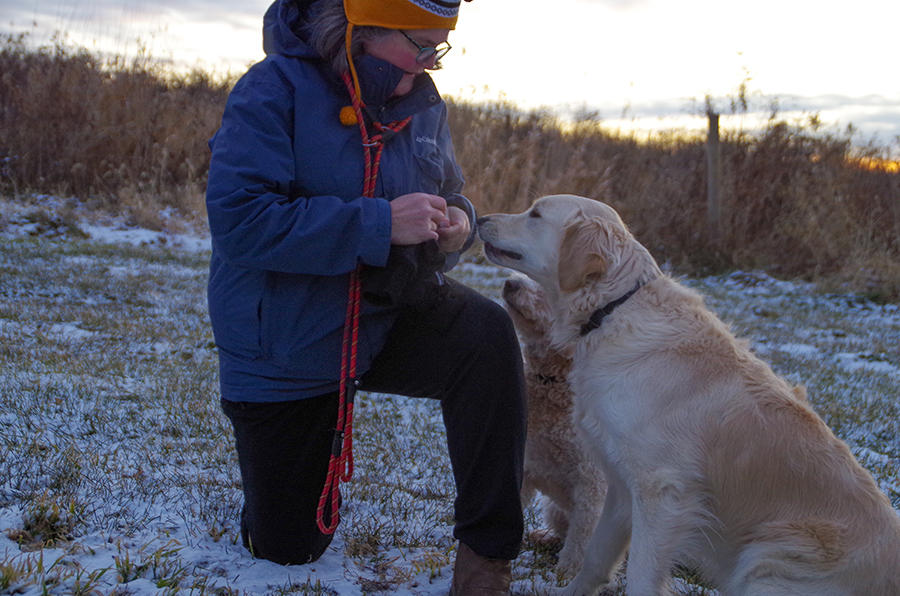The winter blues
Each year, seasonal affective disorder (SAD) affects 10-20% of people globally.
Karen Meyer poses by the stairwell near her classroom Monday, Dec. 16, before returning to teach her Algebra II Honors class.
The changing of the seasons from fall to winter brings about time with family, hot chocolate and snow. However, it also brings shorter days, piled up homework and stressful holidays. For many individuals, the winter does not bring happiness, but instead feelings of depression. People that experience depression during the winter months are often diagnosed with seasonal affective disorder (SAD), also known as major depressive disorder with a seasonal pattern.
SAD, however, includes more than winter depression, or depression linked to cold seasonal change. SAD can include summer depression, where those affected feel depressed during the summer months. Summer depression is much rarer than winter depression as the lack of sunlight is what usually causes SAD.
“[SAD] is essentially just like depression and other major depressive disorders, but it happens during a specific season of the year,” said Devonna Siron, a therapist at Psychiatric Associates in Iowa City.
Math teacher Karen Meyer has never been officially diagnosed with SAD but experiences depression in the winter. She has chosen not to be diagnosed because she already knows how to deal with her SAD.
“I know that I am someone who is affected by this time of the year,” Meyer said. “I know that … when it’s gloomy it can put me into [a mood where] I don’t want to do things and I want to just go home and not go anywhere.”
Winter depression symptoms are caused by a lack of sunlight. In the winter, daylight is shorter than twelve hours. The days get even shorter in the north, so the number of people diagnosed with SAD increases in these areas. People with severe cases of winter depression often use light therapy to help.
Light therapy exposes people to artificial light that mimics natural sunlight. People sit next to a light box for about 15 minutes a day while reading, relaxing or working. Many people use light boxes while eating breakfast. The light enters the eyes indirectly and tricks the brain into thinking it is being exposed to the sun.
“People that have seasonal depression that manifests itself particularly in wintertime, use it to boost serotonin levels and to trick the brain into getting the circadian rhythm back into the pattern that it would normally be in when we have the lighter, longer days,” Siron said.
SAD can also be treated through therapy or medication depending on the severity of the depression. Another common way to treat it is to continue to stay active in the winter months.
“Sometimes seasonal depression isn’t because of the lack of light, sometimes it has to do with behavior change,” Siron said. “A lot of us hunker down because, especially in Iowa, it’s so cold that we don’t feel like doing the same activities that we used to do. So really make sure that you’re getting exercise and spending time with friends and doing all those social things that you would do during the warmer months.”
Meyer’s case of SAD is not severe enough for her to need light boxes, but she makes sure that she stays active to help combat her symptoms.
“I decorated my house super cute right now and spent a lot of time and put up all these lights,” Meyer said. “I make myself, even in the dark, take my dogs for a walk …. I go to bed early and then I wake up pretty early so that when the sun is ready to come up, which is usually around about 6:45 or so, I’m out with my dogs.”
Meyer’s dogs, a mini golden doodle named Scout and a golden retriever named Finn, help push her to get out in the sun every day. Part of the reason she got them was to help with her SAD. She takes them to the Harvest Preserve Foundation, a nonprofit organization that preserves land in the northeast corner of Iowa City.
The area is composed of 100 acres of prairie and woodlands and contains multiple statues throughout the area. Meyer takes her dogs on the many trails in the area and plays fetch with them.
“I watch the sun come up in the morning when I get out there and it’s just these beautiful fields and I think it’s about appreciating the nature around me, I think that that really sort of helps me to grapple [with] it,” Meyer said.
Meyer is not the only one who has pets to help with her mental health. Around 74% of pet owners say that their pets alleviate stress. Positive interactions with pets have been known to increase oxytocin levels, which plays a role in social bonding.
“There’s so much research that shows that just by having a pet and by petting them and snuggling with them and having that support, just makes you feel better,” Siron said.
Meyer’s SAD got really bad seven or eight years ago. She did not know how to deal with it so she spent several years not trying to make a change and just accepting that she was going to have these feelings.
“I found myself just not being motivated to want to go do anything I just wanted to always go home and so I sort of self-diagnosed,” Meyer said. “[I] realized that ‘Hey I’m letting this really get to me.’”
While the choice was difficult, Meyer realized that she needed to force herself to go outside and try to deal with her depression instead of accepting it. She believes it does not help that the weather is such an integral part of everyone’s day. Meyer calls her mother every morning on her way to school and they always discuss the weather together.
“We always say, ‘It’s really sunny today,’ or ‘Oh it looks like it’s going to be kind of cloudy,’ or ‘Oh, isn’t that beautiful Mom. It’s so sunny,’” Meyer said. “And on a day when it’s kind of cloudy, there’s where that choice is made. Yeah, I can see it’s cloudy but you know what I’m going to hope for some sun later today.”
People with SAD can be affected by the holiday season as well. Not only by the commercial aspect of the holidays but also by the memories of family members that have passed away. While the holidays can bring joy, for many people they add stress.
“Our world tells us that it’s all this commercialized stuff and we got to have the newest iPhone and we got to get the newest AirPods and, and then when people can’t afford that, that makes them feel bad,” Meyer said. “… The holiday season can lead people into very sad places, you know relatives have died.”
While Meyer cannot help the feelings she has, she always tries to stay positive throughout the winter. One way she does that is by looking forward to the spring.
“You look forward to seeing the things growing again,” Meyer said. “You see the colors coming back out and you see life again and I think in general that people like that.”
If you are having thoughts of suicide or self-harm please seek professional help or call the crisis helpline: 1-800-273-8255.
Your donation will support the student journalists of West High School. Your contribution will allow us to purchase Scholarship Yearbooks, newsroom equipment and cover our annual website hosting costs.

(she/her) Bess Frerichs is the online managing and feature editor. As a senior, this is her third and final year on staff. She enjoys reading, writing...





